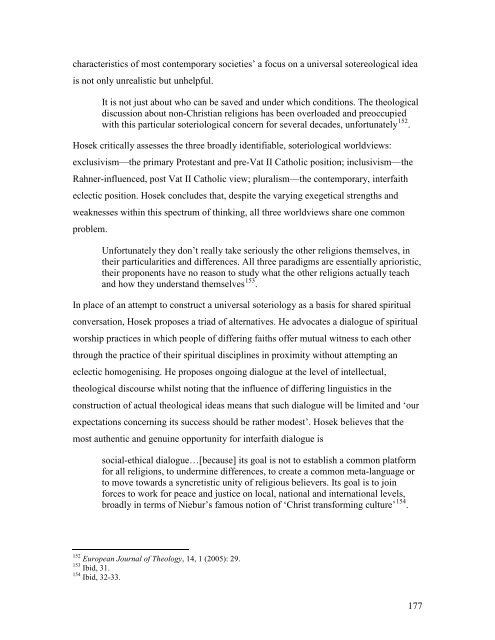Introductory notes for readers of this thesis - Theses - Flinders ...
Introductory notes for readers of this thesis - Theses - Flinders ...
Introductory notes for readers of this thesis - Theses - Flinders ...
Create successful ePaper yourself
Turn your PDF publications into a flip-book with our unique Google optimized e-Paper software.
characteristics <strong>of</strong> most contemporary societies’ a focus on a universal sotereological ideais not only unrealistic but unhelpful.It is not just about who can be saved and under which conditions. The theologicaldiscussion about non-Christian religions has been overloaded and preoccupiedwith <strong>this</strong> particular soteriological concern <strong>for</strong> several decades, un<strong>for</strong>tunately 152 .Hosek critically assesses the three broadly identifiable, soteriological worldviews:exclusivism—the primary Protestant and pre-Vat II Catholic position; inclusivism—theRahner-influenced, post Vat II Catholic view; pluralism—the contemporary, interfaitheclectic position. Hosek concludes that, despite the varying exegetical strengths andweaknesses within <strong>this</strong> spectrum <strong>of</strong> thinking, all three worldviews share one commonproblem.Un<strong>for</strong>tunately they don’t really take seriously the other religions themselves, intheir particularities and differences. All three paradigms are essentially aprioristic,their proponents have no reason to study what the other religions actually teachand how they understand themselves 153 .In place <strong>of</strong> an attempt to construct a universal soteriology as a basis <strong>for</strong> shared spiritualconversation, Hosek proposes a triad <strong>of</strong> alternatives. He advocates a dialogue <strong>of</strong> spiritualworship practices in which people <strong>of</strong> differing faiths <strong>of</strong>fer mutual witness to each otherthrough the practice <strong>of</strong> their spiritual disciplines in proximity without attempting aneclectic homogenising. He proposes ongoing dialogue at the level <strong>of</strong> intellectual,theological discourse whilst noting that the influence <strong>of</strong> differing linguistics in theconstruction <strong>of</strong> actual theological ideas means that such dialogue will be limited and ‘ourexpectations concerning its success should be rather modest’. Hosek believes that themost authentic and genuine opportunity <strong>for</strong> interfaith dialogue issocial-ethical dialogue…[because] its goal is not to establish a common plat<strong>for</strong>m<strong>for</strong> all religions, to undermine differences, to create a common meta-language orto move towards a syncretistic unity <strong>of</strong> religious believers. Its goal is to join<strong>for</strong>ces to work <strong>for</strong> peace and justice on local, national and international levels,broadly in terms <strong>of</strong> Niebur’s famous notion <strong>of</strong> ‘Christ trans<strong>for</strong>ming culture’ 154 .152 European Journal <strong>of</strong> Theology, 14, 1 (2005): 29.153 Ibid, 31.154 Ibid, 32-33.177















